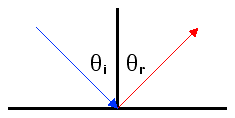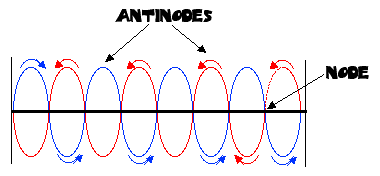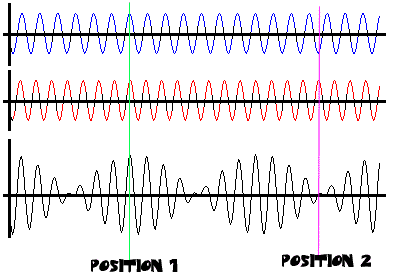
Chapter 14.2 Notes
Reflection, Refraction and Diffraction of waves
The speed of mechanical waves depends only on the properties of the medium.
The amplitude of a wave does not affect its wavelength, frequency, or velocity. The velocity of a wave is higher in a more rigid medium. This typically means that denser materials display higher velocities of mechanical waves.
Reflection. Reflection is the bouncing of a wave off a media interface, such as water waves bouncing off a sea wall, or echoes off a canyon wall.
When a wave approaches a rigid barrier at an angle other than along the normal to the barrier, the incoming wave, known as the incident wave, forms an angle between itself and the normal.

When a wave strikes a media interface, invariably some of the wave is not refleceted, but transmitted into the second medium.
Standing Waves and Interference.
When a wave is reflected from a more rigid medium, the reflected portion is inverted as in the figure below. The red portion is the reflected wave, as what might be expected when a wave on a string is reflected back from an end which might be tied to a post.
Standing waves: Occurs when two identical waves are moving in the opposite direction. such as the condition shown in the figure below where a wave reflecting from a barrier returns through the incident medium inverted. If the frequency and length of the medium are correct, the wave appears motionless. A node is a point in a medium that does not undergo a displacement as the waves pass through each other in the medium. An antinode is a point where the displacement caused by interfering waves is the largest.

The Superposition Principle states that the displacement of a medium caused by the individual waves is the algebraic sum of the displacement caused by the individual waves. Interference is the result of the superposition of two or more waves.
Check the diagram below. There are two waves, one with a slightly different frequency than the other. If the two waves occupy the same medium at the same time, the third wave is the result. Look closely at the line marked "position 1". At this region, the crests of two waves displace the medium in the same direction simultaneously, and constructive interference takes place. At "position 2", the crest of one wave displaces the medium in one direction while the trough of the second displaces it in the opposite direction. The result in that region is destructive interference!

Refraction and Diffraction of Waves
Refraction is the change of the direction of a wave at a media interface.

Not sure what you should be looking at? click here for an enlarged, enhanced view.
Diffraction is the bending of a wave around an object in its path.
Homework Set#3: Ch. 14 questions 13-22